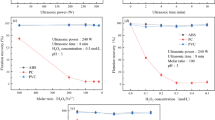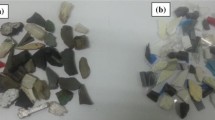Abstract
Selective surface modification of polyvinyl chloride (PVC) by ozonation was evaluated to facilitate the separation of PVC from other heavy plastics with almost the same density as PVC, especially polyethylene terephthalate (PET), by the froth flotation process. The optimum froth flotation conditions were investigated, and it was found that at 40°C, 90% of PVC and PET plastics floated. The bubble size became larger and the area covered with bubbles on the plastic surface was reduced with increasing temperature. Optimum PVC separation was achieved with the flotation solution at 40°C and mixing at 180–200 rpm, even for sheet samples 10 mm in size. Combined treatment by ozonation and froth flotation is a simple, effective, and inexpensive method for PVC separation from waste plastics.
Similar content being viewed by others
References
Plastic Waste Management Institute of Japan (2009) Plastics products, plastic waste and resources recovery. PWMI Newsletter No. 38, pp 1–10. Available at: http://www2.pwmi.or.jp/siryo/ei/ei_pdf/ei38.pdf
Andricic B, Kovacoc T (1999) Non-isothermal degradation of poly (vinyl chloride)/methylmethacrylate-butadiene-styrene blends. Polymer Degrad Stabil 65:59–64
Anthony EJ, Jia L, Granatstein DL (2001) Dioxin and furan formation in FBC boilers. Environ Sci Technol 35:3002–3007
Baum B, Wartman LH (1958) Structure and mechanism of dehydrochlorination of polyvinyl chloride. J Polymer Sci 28:537–546
Marques GA, Tenorio JAS (2000) Use of froth flotation to separate PVC/PET mixtures. Waste Manag 20:265–269
Shen H, Forssberg E, Pugh RJ (2001) Selective flotation separation of polymers by particle control. Resour Conserv Recy 33:37–50
Huiting ES, Pugh RJ (2002) Selective flotation separation of polymers by chemical conditioning with methyl cellulose. Resour Conserv Recy 35:229–241
Miller JD, Drelich J, Payne T, Kim JH, Kobler RW, Christiansen S (1998) Selective froth flotation of PVC from PVC/PET mixtures for the polymers recycling industry. Polymer Sci Eng 38:1378–1386
Hu XH, Calo JM (2005) Enhancement of liquid-fluidized bed classification (LFBC) of plastic particle mixtures via selective thermal particle modification. Powder Technol 151:44–53
Pascoe RD, Hou YY (1999) Investigation of the importance of particle shape and surface wettability on the separation of plastics in a LARCODEMS separator. Miner Eng 12:423–431
Jan HS (2001) New ways to salvage plastic waste. Plastic Technol 47:58–61
Raymond JE (1992) Plastics recycling: products and processes. Hanser, New York
Shibata J, Matsumoto S, Yamamoto H, Kusaka E, Pradip (1996) Flotation separation of plastics using selective depressants. Int J Miner Process 48:127–134
Okuda T, Kurose K, Nishijima W, Okada M (2007) Separation of polyvinyl chloride from plastic mixture by froth flotation after surface modification with ozone. Ozone Sci Eng 29:373–377
Kaczmarek H, Kowalonek J, Szalla A, Sionkowska A (2002) Surface modification of thin polymeric films by air-plasma or UV-irradiation. Surface Sci 507–510:883–888
Kaczmarek H, Szalla A, Chaberska H, Kowalonek J (2004) Changes of surface morphology in UV-irradiated poly(acrylic acid)/poly(ethylene oxide) blends. Surface Sci 566–568:560–565
Kurose K, Okuda T, Nakai S, Tsai T-Y, Nishijima W, Okada M (2008) Hydrophilization of polyvinyl chloride surface by ozonation. Surf Rev Lett 15:711–715
Bolgar M, Hubball J, Groeger J, Meronek S (2007) Handbook for the chemical analysis of plastic and polymer additives. CRC, Raton, USA
Atek D, Bensemra B (2005) FTIR investigation of the specific migration of additives from rigid poly(vinyl chloride). Eur Polymer J 41:707–714
Author information
Authors and Affiliations
Corresponding author
Rights and permissions
About this article
Cite this article
Reddy, M.S., Okuda, T., Kurose, K. et al. Surface ozonation of polyvinyl chloride for its separation from waste plastic mixture by froth floatation. J Mater Cycles Waste Manag 12, 326–331 (2010). https://doi.org/10.1007/s10163-010-0305-x
Received:
Accepted:
Published:
Issue Date:
DOI: https://doi.org/10.1007/s10163-010-0305-x




